Passitexams
On this page, you find all documents, package deals, and flashcards offered by seller PassitExams.
- 307
- 0
- 10
Community
- Followers
- Following
317 items
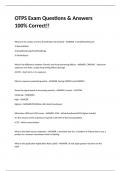
OTPS Exam Questions & Answers 100% Correct!!
What are the modes of entry of pesticides into body(4) - ANSWER 1) Oral(MouthTissue) 2) Dermal(Skin) 3) Inhalation(LungsFromBreathing) 4) Ocular(Eyes) What's the difference between Chronic and Acute poisoning/effects - ANSWER CHRONIC - long-term exposure over time; usually long-lasting effects/damage ACUTE - short-term or 1x exposure When is exposure potential greatest - ANSWER During MIXING and LOADING Name the signal words in increasing severity - ANSWER Lowest - CAUTION Mod...
- Exam (elaborations)
- • 11 pages •
What are the modes of entry of pesticides into body(4) - ANSWER 1) Oral(MouthTissue) 2) Dermal(Skin) 3) Inhalation(LungsFromBreathing) 4) Ocular(Eyes) What's the difference between Chronic and Acute poisoning/effects - ANSWER CHRONIC - long-term exposure over time; usually long-lasting effects/damage ACUTE - short-term or 1x exposure When is exposure potential greatest - ANSWER During MIXING and LOADING Name the signal words in increasing severity - ANSWER Lowest - CAUTION Mod...
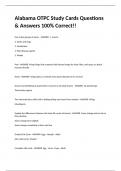
Alabama OTPC Study Cards Questions & Answers 100% Correct!!
Five mains groups of pests. - ANSWER 1. Insects 2. Snails and slugs 3. Vertebrates 4. Plant disease agents 5. Weeds Pest - ANSWER living things that compete with human beings for food, fiber, and space or attach humans directly Hosts - ANSWER living plants or animals some pests depend on for survival Name two identifying characteristics common to all adult insects - ANSWER Six jointed legs Three body regions
- Exam (elaborations)
- • 15 pages •
Five mains groups of pests. - ANSWER 1. Insects 2. Snails and slugs 3. Vertebrates 4. Plant disease agents 5. Weeds Pest - ANSWER living things that compete with human beings for food, fiber, and space or attach humans directly Hosts - ANSWER living plants or animals some pests depend on for survival Name two identifying characteristics common to all adult insects - ANSWER Six jointed legs Three body regions
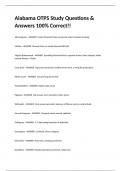
Alabama OTPS Study Questions & Answers 100% Correct!!
Johnsongrass - ANSWER Coarse Perenial, Does not persist under frequent mowing Mullein - ANSWER Densely-hairy or woolly biennial (6ft tall) Virginia Buttonweed - ANSWER Spreading Perennial herb, opposite leaves, lance shaped, white tubular flowers, 4 lobes
- Exam (elaborations)
- • 3 pages •
Johnsongrass - ANSWER Coarse Perenial, Does not persist under frequent mowing Mullein - ANSWER Densely-hairy or woolly biennial (6ft tall) Virginia Buttonweed - ANSWER Spreading Perennial herb, opposite leaves, lance shaped, white tubular flowers, 4 lobes
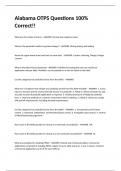
Alabama OTPS Questions 100% Correct!!
What are the modes of entry? - ANSWER Dermal oral respitory ocular When is the pesticide handler in greatest danger? - ANSWER During mixing and loading Name the signal words from least toxic to most toxic. - ANSWER Caution, Warning, Danger, Danger "poison"
- Exam (elaborations)
- • 2 pages •
What are the modes of entry? - ANSWER Dermal oral respitory ocular When is the pesticide handler in greatest danger? - ANSWER During mixing and loading Name the signal words from least toxic to most toxic. - ANSWER Caution, Warning, Danger, Danger "poison"
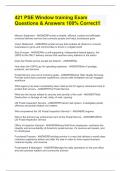
421 PSE Window training Exam Questions & Answers 100% Correct!!
Mission Statement - ANSWERProvide a reliable, efficient, trusted and affirdable universal delivery service that connects people and helps businesses grow Vision Statement - ANSWERA postal service that enables all citizens to connect, businesses to grow and communities to thrive in a digital world Size & scope - ANSWERAs a self-supporting, independent federal agency, the USPS is the ONLY delivery service that reaches every address in the nation Does the Postal service accept tax dollars?...
- Exam (elaborations)
- • 7 pages •
Mission Statement - ANSWERProvide a reliable, efficient, trusted and affirdable universal delivery service that connects people and helps businesses grow Vision Statement - ANSWERA postal service that enables all citizens to connect, businesses to grow and communities to thrive in a digital world Size & scope - ANSWERAs a self-supporting, independent federal agency, the USPS is the ONLY delivery service that reaches every address in the nation Does the Postal service accept tax dollars?...
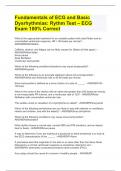
Fundamentals of ECG and Basic Dysrhythmias: Rythm Test – ECG Exam 100% Correct
What is the appropriate treatment for an unstable patient with atrial flutter and an uncontrolled ventricular response; HR >150 beats per minute? - ANSWERDefibrillation Caffeine, alcohol, and fatigue can be likely causes for (Select all that apply.) - ANSWERAtrial flutter Sinus pause Atrial fibrillation Ventricular tachycardia Which of the following conditions/situations may cause bradycardia? - ANSWERHypoxia Which of the following is an accurate statement about sinus bradycardia?...
- Exam (elaborations)
- • 3 pages •
What is the appropriate treatment for an unstable patient with atrial flutter and an uncontrolled ventricular response; HR >150 beats per minute? - ANSWERDefibrillation Caffeine, alcohol, and fatigue can be likely causes for (Select all that apply.) - ANSWERAtrial flutter Sinus pause Atrial fibrillation Ventricular tachycardia Which of the following conditions/situations may cause bradycardia? - ANSWERHypoxia Which of the following is an accurate statement about sinus bradycardia?...
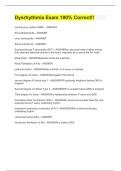
Dysrhythmia Exam 100% Correct!!
normal sinus rhythm (NSR) - ANSWER Sinus Bradycardia - ANSWER sinus tachycardia - ANSWER Sinus Arrhythmia - ANSWER Supraventricular Tachycardia (SVT) - ANSWERan abnormal heart rhythm arising from aberrant electrical activity in the heart; originates at or above the AV node atrial flutter - ANSWERbaseline looks like sawtooth Atrial Fibrillation (A-Fib) - ANSWER
- Exam (elaborations)
- • 1 pages •
normal sinus rhythm (NSR) - ANSWER Sinus Bradycardia - ANSWER sinus tachycardia - ANSWER Sinus Arrhythmia - ANSWER Supraventricular Tachycardia (SVT) - ANSWERan abnormal heart rhythm arising from aberrant electrical activity in the heart; originates at or above the AV node atrial flutter - ANSWERbaseline looks like sawtooth Atrial Fibrillation (A-Fib) - ANSWER
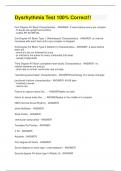
Dysrhythmia Test 100% Correct!!
First Degree AV Block Characteristics - ANSWER- P wave before every qrs complex - P waves are upright and uniform - LONG PR INTERVAL 2nd Degree AV Block Type 1 (Wenkebach) Characteristics - ANSWER- pr interval increases with each beat until a qrs complex is dropped 2nd Degree AV Block Type 2 (Mobitz II) Characteristics - ANSWER- p wave before each qrs - some p's are not followed by a qrs - pr interval is the same for every conducted (full) beat - usually bradycardic Third Degree A...
- Exam (elaborations)
- • 2 pages •
First Degree AV Block Characteristics - ANSWER- P wave before every qrs complex - P waves are upright and uniform - LONG PR INTERVAL 2nd Degree AV Block Type 1 (Wenkebach) Characteristics - ANSWER- pr interval increases with each beat until a qrs complex is dropped 2nd Degree AV Block Type 2 (Mobitz II) Characteristics - ANSWER- p wave before each qrs - some p's are not followed by a qrs - pr interval is the same for every conducted (full) beat - usually bradycardic Third Degree A...
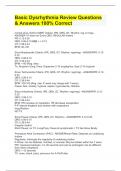
Basic Dysrhythmia Review Questions & Answers 100% Correct
normal sinus rhythm (NSR) Criteria: (PR, QRS, QT, Rhythm: reg or irreg) - ANSWER1 P-wave for Every QRS, REGULAR rhythm PR: 0.12-0.20 QRS: 0.06-0.10 BBB = > 0.12 QT: 0.36-0.44 BPM: 60-100 Sinus Bradycardia Criteria: (PR, QRS, QT, Rhythm: reg/irreg) - ANSWERPR: 0.12-0.20 QRS: 0.06-0.10 QT: 0.36-0.44 BPM: < 60 (Reg. rate) Tx: Atropine 0.5mg, Pace, Dopamine 2-10 mcg/kg/min, Epie 2-10 mcg/min Sinus Tachycardia Criteria: (PR, QRS, QT, Rhythm: reg/irreg) - ANSWERPR: 0.12-0.20 QRS: ...
- Exam (elaborations)
- • 6 pages •
normal sinus rhythm (NSR) Criteria: (PR, QRS, QT, Rhythm: reg or irreg) - ANSWER1 P-wave for Every QRS, REGULAR rhythm PR: 0.12-0.20 QRS: 0.06-0.10 BBB = > 0.12 QT: 0.36-0.44 BPM: 60-100 Sinus Bradycardia Criteria: (PR, QRS, QT, Rhythm: reg/irreg) - ANSWERPR: 0.12-0.20 QRS: 0.06-0.10 QT: 0.36-0.44 BPM: < 60 (Reg. rate) Tx: Atropine 0.5mg, Pace, Dopamine 2-10 mcg/kg/min, Epie 2-10 mcg/min Sinus Tachycardia Criteria: (PR, QRS, QT, Rhythm: reg/irreg) - ANSWERPR: 0.12-0.20 QRS: ...
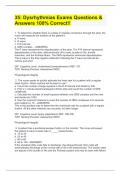
35: Dysrhythmias Exams Questions & Answers 100% Correct!!
1. To determine whether there is a delay in impulse conduction through the atria, the nurse will measure the duration of the patient's a. P wave. b. Q wave. c. P-R interval. d. QRS complex. - ANSWERA The P wave represents the depolarization of the atria. The P-R interval represents depolarization of the atria, atrioventricular (AV) node, bundle of His, bundle branches, and the Purkinje fibers. The QRS represents ventricular depolarization. The Q wave is the first negative deflection follow...
- Exam (elaborations)
- • 40 pages •
1. To determine whether there is a delay in impulse conduction through the atria, the nurse will measure the duration of the patient's a. P wave. b. Q wave. c. P-R interval. d. QRS complex. - ANSWERA The P wave represents the depolarization of the atria. The P-R interval represents depolarization of the atria, atrioventricular (AV) node, bundle of His, bundle branches, and the Purkinje fibers. The QRS represents ventricular depolarization. The Q wave is the first negative deflection follow...
